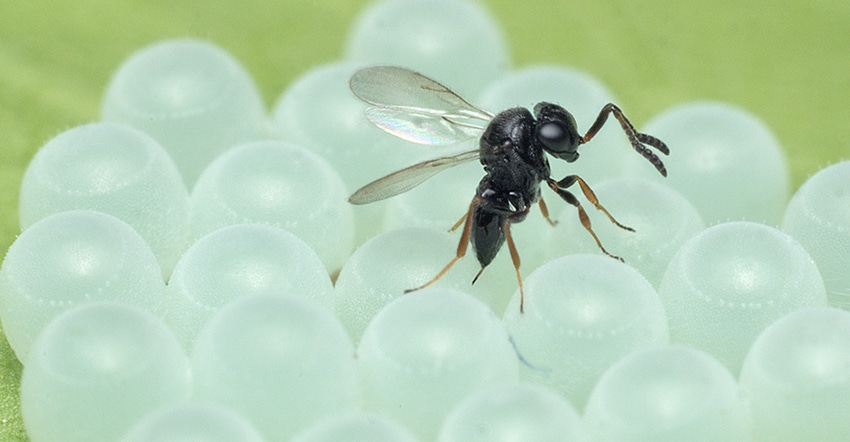June 28, 2019

The marmorated stinkbug is a pest that plagues a wide range of crops around the country. There’s an effective biological control for the invasive crop-eating pest, but how best to use that approach in conjunction with insecticides? Oregon State University researchers have found an answer.
In a study published recently in the Journal of Economic Entomology, the researchers advanced the understanding of using the samurai wasp for biological control of the stinkbug, and that work has significant implication for growers of orchard fruits and nuts.
David Lowenstein, a postdoctoral research associate in OSU’s College of Agricultural Sciences, was lead author on the study.
Biological control can reduce pesticide use and is a potential valuable tool for control of the brown marmorated stinkbug, which is native to East Asia. The bug has a taste for more than 100 crop types including blueberries, winegrapes, cherries and hazelnuts. The bug, which invaded the U.S. in the 1990s, can now be found in 44 states, and it causes millions of dollars of crop damage annually.
With funding from USDA’s Specialty Crop Research Initiative, more than 50 researchers across the U.S. are studying the stinkbug to find management solutions, including those at OSU.
The stinkbug was first detected in Oregon in 2004. Researchers have found it in 24 of Oregon’s 36 counties, and in all of the state’s major fruit-producing regions. The bug also causes trouble when aggregating on the sides of homes and sheds in the fall.
Smaller than a pinhead, the samurai wasp is native to the same region in East Asia as the stinkbug. It lays its eggs inside stinkbug eggs, preventing stink bugs from hatching. How the wasp arrived in the U.S. is unknown, but it showed up in Oregon’s Willamette Valley in 2016.
The OSU study investigated the impacts of different insecticides commonly used in orchard crops. The aim was to measure the impact on samurai wasp survival and reproduction. Some insecticides were lethal to the wasp, and a few were compatible with using the wasp for biological control.
Lowenstein says research was necessary for growers, especially those in the state’s hazelnut industry. They use insecticides, but also want to use the wasp as a control for stinkbugs. Those growers want to know which insecticides will be less harmful to the wasp, and when to spray.
Notes Lowenstein: “Since the discovery of the samurai wasp in Oregon, our research group at OSU has proposed biocontrol for managing the brown marmorated stinkbug. We needed to validate the compatibility of this wasp in a commercial environment where insecticides are being used.”
A look at the study
Researchers studied wasp compatibility with nine conventional and organic insecticides commonly used in integrated pest management in perennial crops, both in the lab and in three hazelnut orchards in the valley.
They found the active ingredient in two insecticide classes — neonicotinoids and pyrethroids — killed more samurai wasps than the others, both in the field and the lab. Both classes are broad-spectrum insecticides, designed to kill or manage a variety of insects.
However, more than 50% of wasps survived contact with insecticides targeted to control chewing insects, such as filbertworm larvae, in hazelnut.
“For someone who wants biological control for samurai wasp, it’s best to time it when you aren’t applying chemicals — unless you are using the more targeted compounds,” Lowenstein says.
Orchards may also benefit from biological control if samurai wasps are released in unsprayed areas adjacent to agriculture and in urban areas. In the last two-and-and-half years, OSU has released the wasp at about 60 sites in the state. At about 40% of those sites, the wasp has survived into the following season.
The wasp isn’t currently commercially available. OSU rears it mainly for research, but insects can be distributed to an Oregon location on request, Lowenstein says, adding that the insect is not harmful to people.
“There’s no way you are going to confuse this with a yellow jacket. They aren’t interested in stinging people,” he says. “If you have a samurai wasp on your property, you won’t even know it’s there unless you are seeing its effect, which is less stinkbugs.”
The study was funded by the Oregon Hazelnut Commission, the Oregon Raspberry and Blackberry Commission and the USDA National Institute of Food and Agriculture.
Source: Oregon State University. The source is solely responsible for the information provided and is wholly owned by the source. Informa Business Media and all its subsidiaries are not responsible for any of the content contained in this information asset.
You May Also Like




